#the solitary life
Text
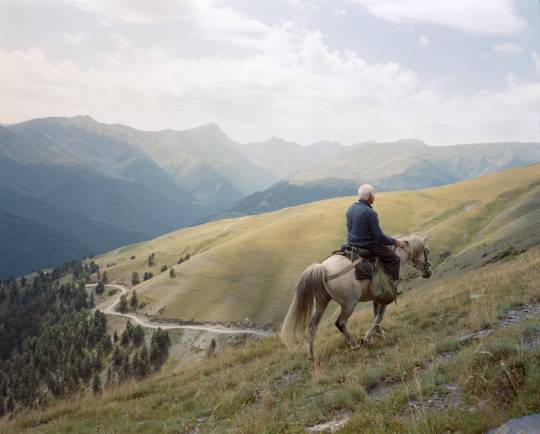



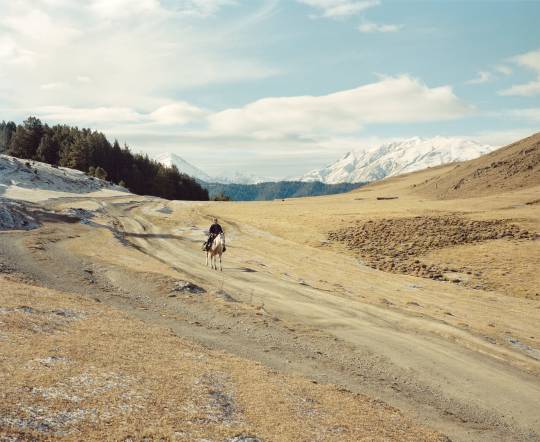

Irakl Khvedaguridze, 81, is the only licensed doctor across 386 sq miles of mountainous region, serving a dwindling community of Tush people in north-east Georgia. During the summer and early autumn, he gets to his patients on his white horse, Bichola. When the snow gets too deep, Khvedaguridze converts his shoes into skis using birch planks nailed with wide canvas. Once the snow rises above his knees, he can only travel on foot (x)
4K notes
·
View notes
Text
yeah john watson would be using his lucky condom on a man wouldn't he
211 notes
·
View notes
Note
what does it mean when people say stuff like individual morality or action is incompatible with class analysis or class struggle?
alright so like one of the key ideas about class analysis is the idea that classes (as a whole) have economic interests that affect all their members but don't extrapolate out to an individual analysis.
for example, let's say that you can't find a job, and somebody offers to pay you below the table for below minimum wage. it's in your individual interest to do this--it beats having no job! but as a member of the working class, once this practice becomes normalized, suddenly the standards of pay for everyone are lower because people know that they can just pay less than minimum wage under the table. competition between workers for jobs drives wages down for everyone, leaving them all in a worse situation overall even if each individual choice to scab, to accept lower pay, to resist unionization, etc, leaves the person who makes it better off. cf. karl marx on what happens when wages and working conditions deteriorate:
The labourer seeks to maintain the total of his wages for a given time by performing more labour, either by working a great number of hours, or by accomplishing more in the same number of hours. Thus, urged on by want, he himself multiplies the disastrous effects of division of labour. The result is: the more he works, the less wages he receives. And for this simple reason: the more he works, the more he competes against his fellow workmen, the more he compels them to compete against him, and to offer themselves on the same wretched conditions as he does; so that, in the last analysis, he competes against himself as a member of the working class.
— Karl Marx, Wage Labour & Capital
similarly, any individual member of the working class is completely dispensable and replaceable by capital. if one person refuses to work unless they're paid a higher wage, they'll be fired and replaced with somebody who doesn't. the individual worker has no economic leverage whatsoever. but the working class has incredible economic leverage! and so does the intermediate stage between the working class and the individual--organized segments of the working class (e.g. trade unions) have economic leverage. if one person strikes, the capitalist can fire them. if 40,000 people strike, your industry is going to shut down.
so the reason why class analysis is compatible with individual action is that your incentives measurably change when you start organizing--it's in the interests of the individual to compete, but in the interests of the class to cooperate. and obviously you cannot just expect everyone to spontaneously coordinate! you, the individual, are disposable to capital! if you, personally, refuse to take the under-the-table offer, either on moral grounds or because you recognize your class interest, your neighbour's going to take it--unless you and her get together and agree that neither of you will take it. that's the only way that the guy making the offer is going to have to give in and offer the job for a living wage.
and this is what organization is--trade unions (although they have severe limitations!), communist parties, and other worker's organizations allow the working class to pursue their collective interest--which can only be pursued by collective action, because engaging in the strategies of collective action as an individual, without the cooperation of your peers, is high risk for no reward.
#ask#marxism#the effects of electoral politics are far far more limited in scope than trade union activity but the same holds for voting#which is what the original post i was responding to was about#if you 'vote blue no matter who' then the bourgeois party you're showing loyalty to--#--will have no reason whatsoever to even marginally offer to improve your life#and if you as a solitary individual tell joe biden 'well im not voting for you unless you promise so and so social democratic reforms'#he is gonna be like lol lmao dont care#while if you and your several thousand friends all get together and say that#he will at least be obligated to pretend to care before immediately reneging on it bc he ultimately serves capital
853 notes
·
View notes
Text
if it's not obvious already, i headcanon that there's something severely wrong with guy that's masked with his upbeat personality
#redacted audio#redacted asmr#redacted guy#the fact that he wants to be a writer#something that's introspective and like. a solitary activity#just interests me#something about him... something about him forreal#i think that he's a competitive overachiever#like he HAS to strive for something and constantly be on the move / a state of chasing#for life to be exciting for him#his fear is being stagnant and settling for less#because he wouldnt settle for less no matter what his situation is#that being said it'd be a very slippery slope once he's at the top and gets what he wants#bc what is there left to live forf
98 notes
·
View notes
Text
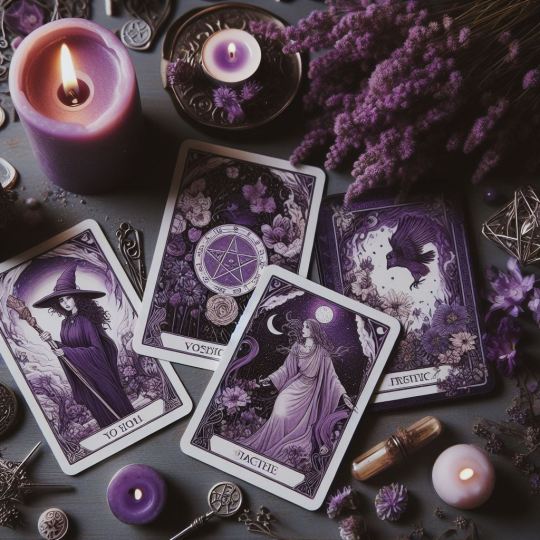
#astrology#magic#magick#modern witch#paganism#solitary witch#tarot#tarot cards#tarot magic#wicca#witch#witch aesthetic#witchcore#witchcraft#witchery#witch life#witch stuff#witch style#witch things#witch vibes#witchy#witchy aesthetic#witchy stuff#witchy things#witchy vibes
95 notes
·
View notes
Text

Yeah I'm not sorry about this
#im also absolutely not explaining how it happened#this is now just exists#my art#grian#smallishbeans#solitary#jimmy solidarity#limited life#limited life grian#limited life joel#limited life jimmy#joel smallishbeans#bad boys#limited life bad boys
662 notes
·
View notes
Text
Starlo should be Clover's dad
Why? Because ↓
1) Both dress into cowboy-themed attire to feel braver/more important than they are
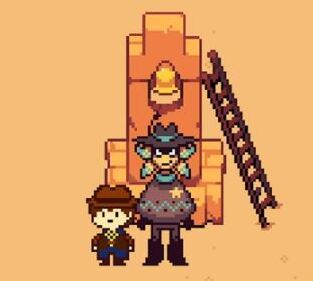
2) Clover, instead of a regular kid, wants to feel like a hero; Star, instead of a regular farmer, also wants to feel like a hero
In reality, Star is not the tough guy he pretends to be. His optimism, protectiveness and caring nature make him a hero though.
In reality, Clover started off as a scared kid who became more confident and skilled thanks to Flowey's resets. Their heroism comes from their forgiving and selfless nature and the hidden courage they got the chance to explore.
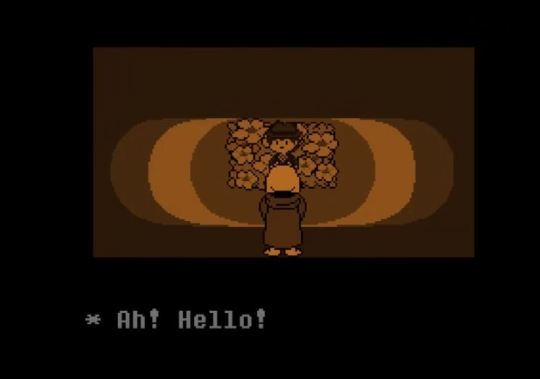
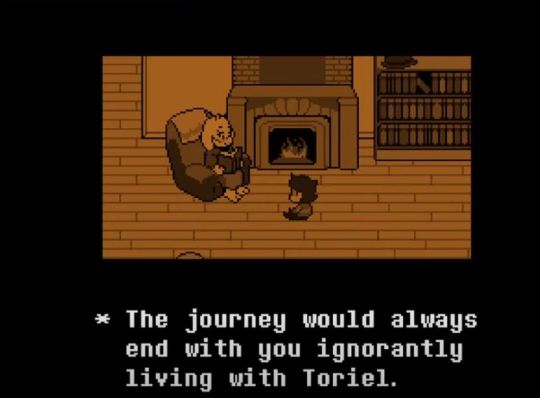
2) Both acted childish during a dangerous situation
Clover came down the mountain with a toy gun so that it would bring them comfort/they'd feel more in control of the situation (if you remember, Frisk refused to play with Asriel's toys in UT, saying how they're "too old," and I assume Frisk and Clover are the same age).
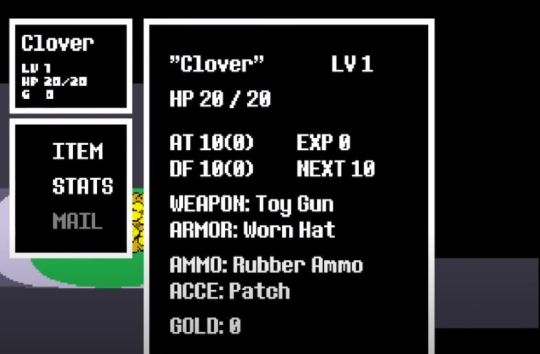
Starlo brought a fake gun before confronting Clover in genocide, just to feel cool.
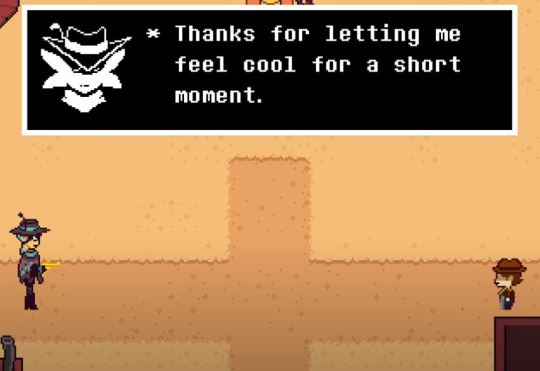
3) Both not only value justice, but base it on compassion
Clover's entire mission was to bring justice (avenge the kids), but along the way changed that mindset (in pacifist). Star says how him and his posse aren't bandits, tests Clover's sense of justice and morality with the trolley problem, and wants to give Ceroba a second chance despite her actions.
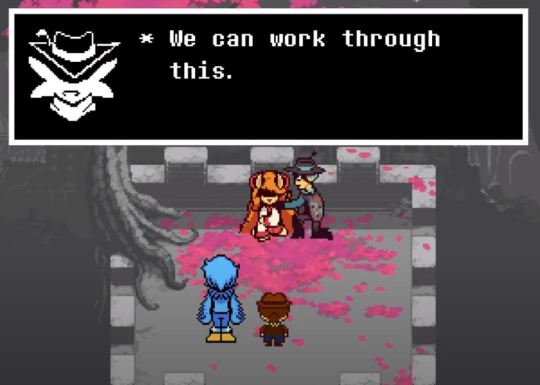
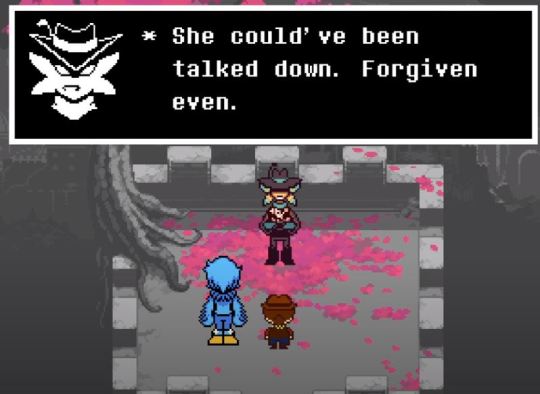
4) Starlo's got protective fatherly instincts
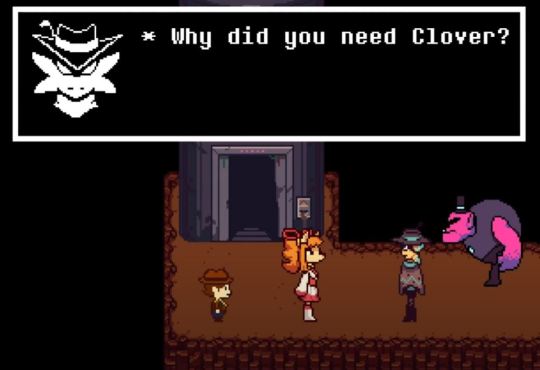

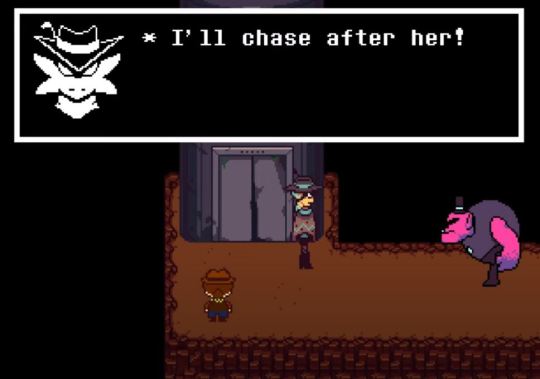
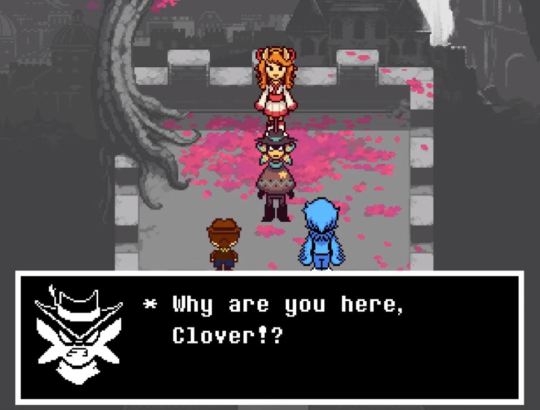
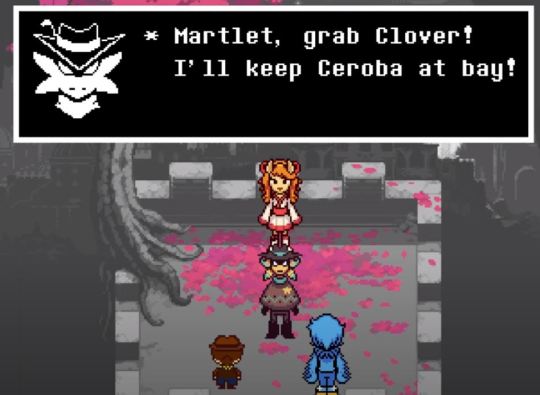

5) fatherly pride


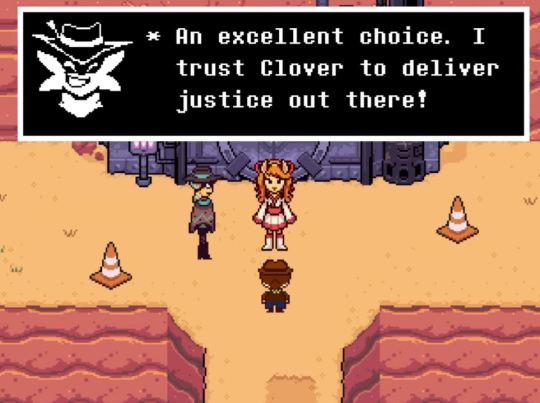

8) a lot of monsters associate Clover with the Dunes/Wild East
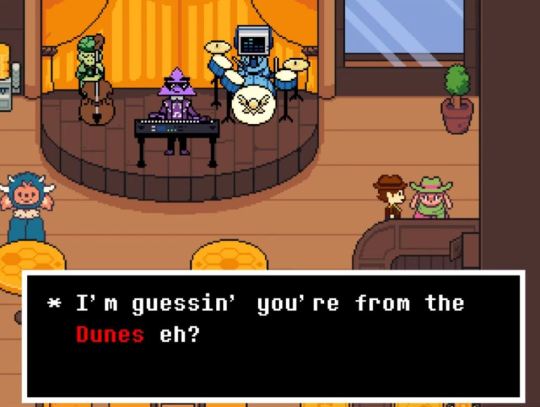

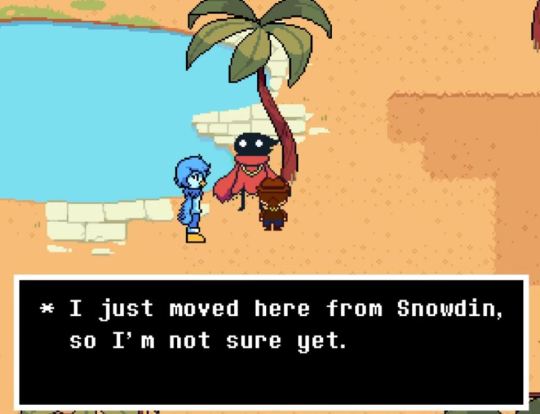
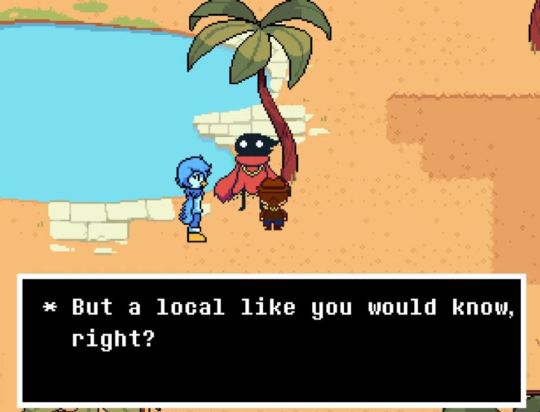
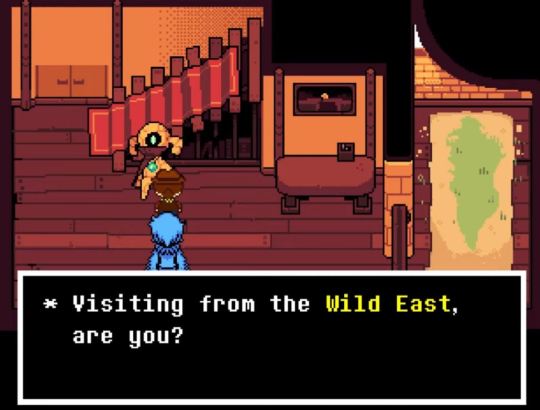
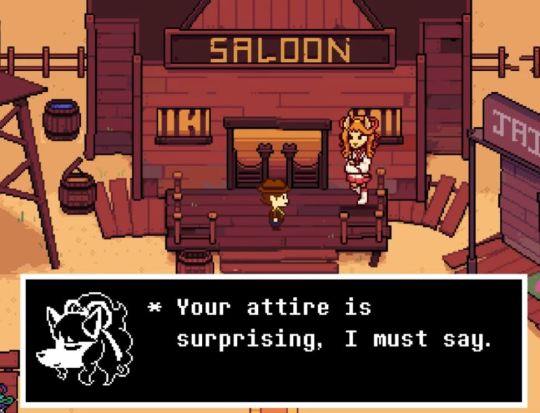
9) oh and... Starlo referred to the Wild East as Clover's.... home. Twice.


he could have easily said 'Wild East'
... get the adoption papers.
#uty#undertale yellow#starlo uty#uty starlo#uty clover#clover uty#no i don't see him as their big brother#or cool uncle#just their dad#i'm crying#i can just hope clover got revived after the barrier was broken#and they got to live a happy life with their pa#dadlo#just look at them#JUST LOOK#I mean I can't imagine anyone else taking on this role for Clover#Dalv is responsible but I think he enjoys his solitary life too much#Martlet means we'll but she's still young and scatterbrained#As for ceroba? I don't think she's mentally ready to raise another child after...#well... everything#Plus crestina wants for star to settle down#Well guess what now you have a grandchild#I forgot about the time orion said to Clover about clover: “must be one of those wild east folk”#And the time star told his kid: “make yourself at home”
81 notes
·
View notes
Note
I love your werehog sonic and tails art because no one draws them together enough also I love how it looks like that werehog sonic would definitely use his teeth to pick tails up by his scruff and I’m here for it
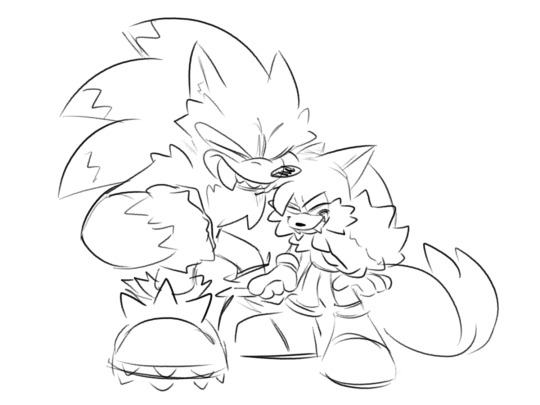

AHHH thank you!
take them. an offering
they are dog bros. canid comrades if you will.
#sth#sonic the hedgehog#tails the fox#miles tails prower#ask#i just like the idea of them together#funky puppy brothers#tails doesnt have any other canids in his life#foxes are solitary but the kits still stick to the momma#so i like to think werehog can provide some positive dog influence tails is missing#dunkinreqs#dunkinsart
360 notes
·
View notes
Text
My friend tried to be my wingman and was talking me up to my crush cause they were at the same party and my crush fully goes “oh I don’t like Hannah like that” and my friend had to save it by being like “oh nah she justs think ur chill and wants to hang” and he called me relaying all of this information and I have never felt so many horrifyingly embarrassing emotions at one time
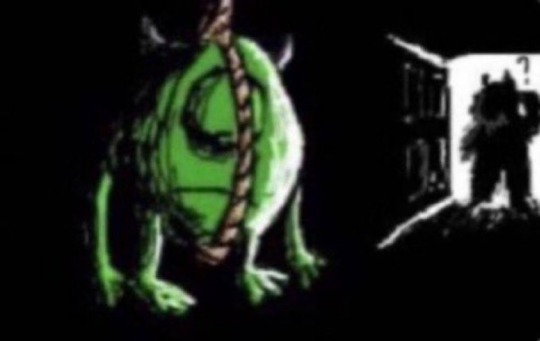
#literally gonna vomit I’ve been embarassing myself in front of them for MONTHS only for them to not like me#this is why I prefer the life of a solitary ascetic monk#I’m gonna go lie down and let the bugs strip the skin from my body leaving only bones#talk to y’all later 🚶🏻♀️
22 notes
·
View notes
Text
yes, jango genuinely and absolutely loved boba as a son. yes, he also left boba posthumous instructions to seek out dangerous individuals with the express intent of destroying his trust in others by exposing him to harm and possibly death at their hands.
understanding jango's character means understanding that he would not even REMOTELY consider these two facts to be contradictory <3
#boba fett#jango fett#listen. it is not nearly as interesting (and also not supported by the text imo) to conclude that jango fett is incapable of love.#he loved boba. hell one could convincingly argue that he loved ZAM too#and not only did it not stop him from doing any of the things he did—in many cases it expressly MOTIVATED him to do them#jango's the sole survivor of a massacre twice over who is essentially trying to correct his own ''mistakes'' through his son#to make a version of him who never trusted anyone and never cared for anyone and therefore never suffered through what he did#trying to mold his son into a perfect solitary ruthless killing machine is 100% an act of love in his mind#plus it makes it 10000x more devastating when later in life boba is convinced he's incapable of caring for or loving anyone—#even though it's almost comically obvious to the reader that this isn't the case—#bc /he doesn't love them like his father loved him/#never realizing that uh. that's not necessarily a bad thing...#boba fett meta
112 notes
·
View notes
Text
instagram
Palestinian Red Crescent workers comforting little children terrified to use a crossing because they fear they'll get killed... where does one even begin? A child at this age should be worried about monsters under their bed, dentist's appointments, having to get out of bed for school. Not that another human being will try to kill them. And the brave rescue workers putting on smiles and pulling out juice cartons, tickling them to bring out a smile and maintain the illusion of safety...
#may every person that contributed to this genocide live a nice long life in solitary confinement#may they rot alive in their jail cells while hearing news of a liberated palestine#i found this on Instagram but it really won't leave my heart so i had to share#these children are the best of us being forced into the worst atrocity any human could experience#from the river to the sea palestine will be free#palestine#Instagram
19 notes
·
View notes
Photo

Frieda Fromm-Reichmann (1990)
1K notes
·
View notes
Text
Since WWX is able to hear the voices of resentful spirits due to his cultivation, I wonder if, when he was in Burial Mounds desperately creating his cultivation in order to survive, it just got louder and louder the further along he got...
#mdzs#mdzs textpost not art#I love this ability of his a lot but god it must suck a ton too#this man absolutely had to master the art of selective hearing I swear#luckily it seems to only be awful in places super rich in resentful energy but god#burial mounds must have been SCREECHING...#man that one moment where he says it’s loud in his second life...I won’t forget it#god the poor boy must have been so scared at first when it started#considering his three months of torture hell at BM can also constitute as solitary confinement...it’s a wonder he walked out aware at all
501 notes
·
View notes
Text
have not left bed today + found out another friend got locked up + want to beat up every single adult that saw what was happening to me and looked away or actively made it worse
#personal#vent#suicide mention tw#i need to call her. last time we talked she said she was going to kill herself if she got incarcerated again#i love her. nothing makes me more angry at so many systems than trying to do suicide support with my friends who are locked up#trying to do this shit over the phone with people listening in. trying to figure out what meaningful support we can even give#because when she says that death is better than months of solitary i know exactly how she feels and what she means and i cannot fucking#most of the skills mainstream peer support has ever taught me are useless in that situation and my best is not enough#there are so many places that need to be burnt down.#there are so many people i love who are not out and it starts to kill me a little bit#and cops are starting to fuck with us here more. i've gotten bruised up a couple times from being shoved around#nothing too bad yet but just#jesus christ#sorry for coming on here to vent all the time but my offline life is a little crazy at the moment and half this shit i can't talk about irl#i honestly think i need to like. start learning how to fight properly again. bc i have so much anger right now#and learning how to actually fight sounds like a better idea then fucking off and getting into random fights like i used to#idk. will look into it
29 notes
·
View notes
Text
So much to say,
But no one that listens.
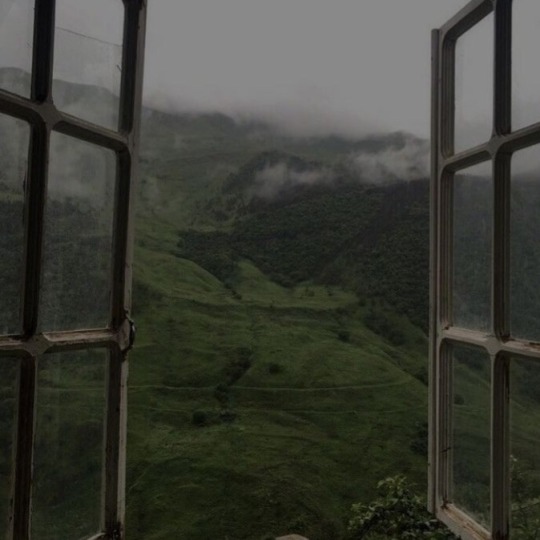
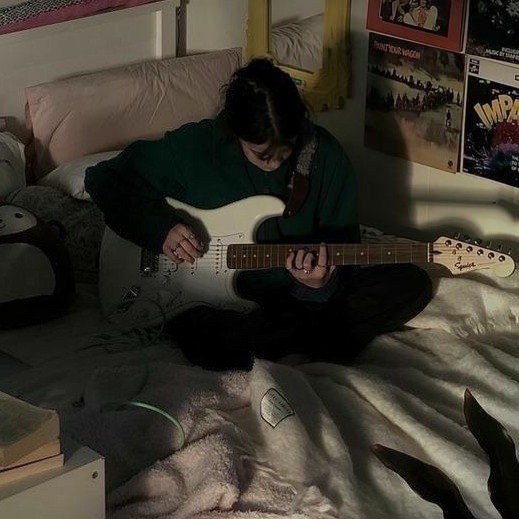
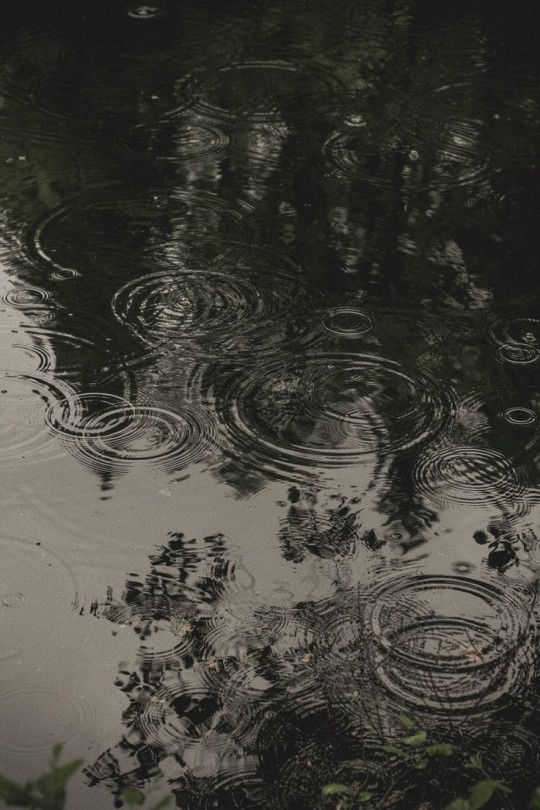
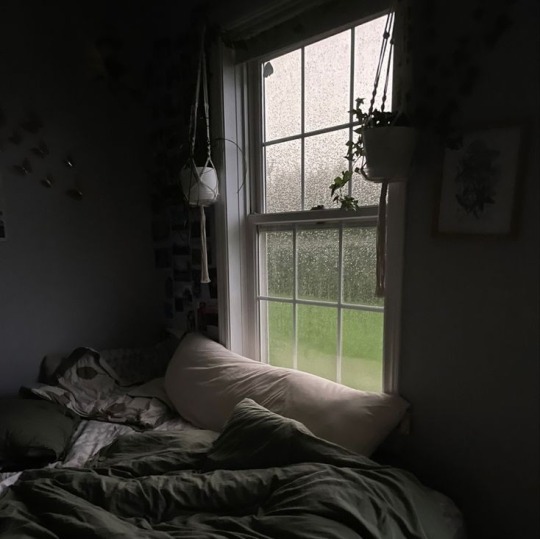
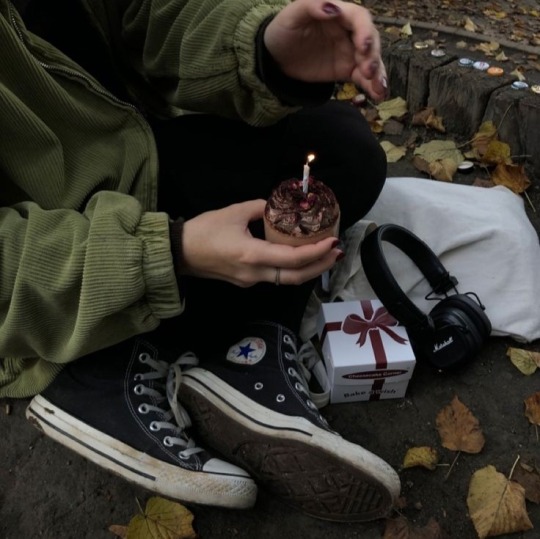
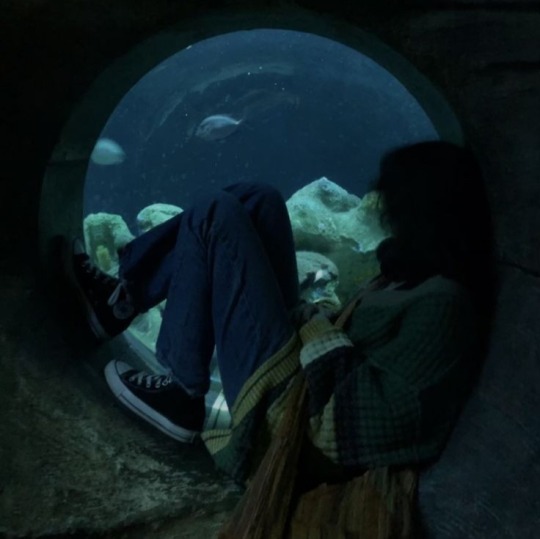
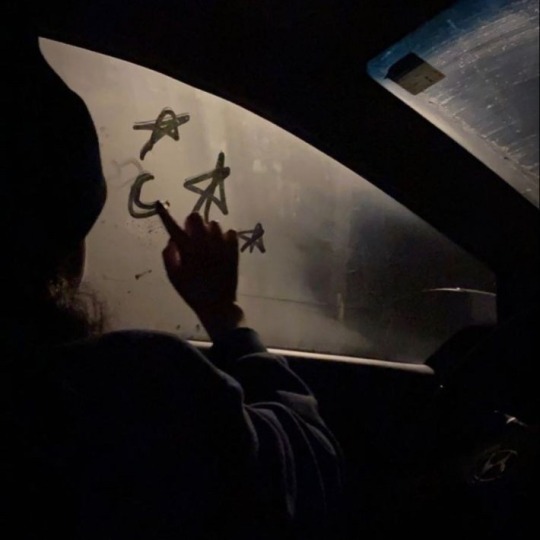
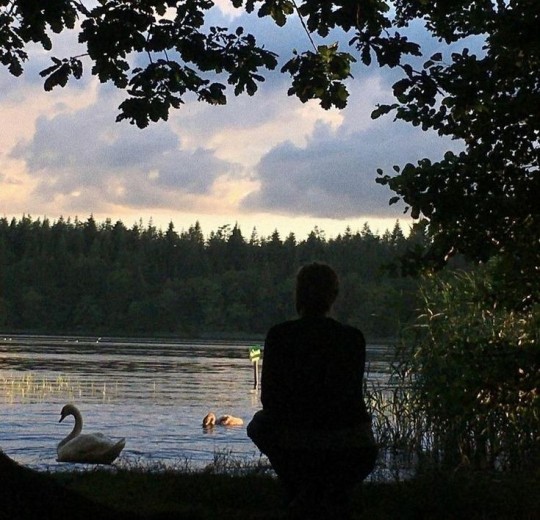
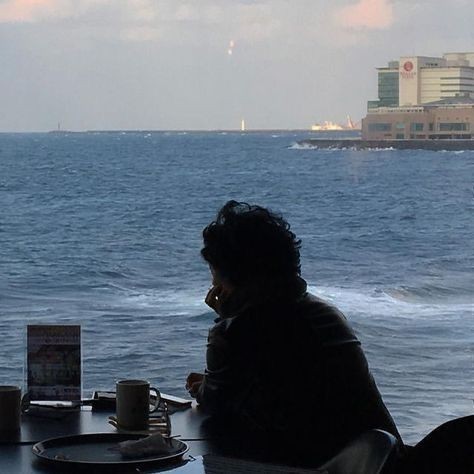
sd<३
#dark acadamia aesthetic#rains#quotes#spilled thoughts#spilled ink#gloomy weather#writing#art#astheic#sad quotes#dark academic aesthetic#light academia#dark academia#dark academia moodboard#rainy aesthetic#old aesthetic#aesthetic#aesthetics#solitary life#solitude#lonelly#lonliness#love#silence#leave me alone#introvert#understanding
87 notes
·
View notes
Text


#black cat#dreamcatcher#magic#magick#modern witch#paganism#solitary witch#wicca#witch#witch aesthetic#witch cat#witchcore#witchcraft#witchery#witch interior#witch life#witch stuff#witch style#witch things#witch vibes#witchy#witchy aesthetic#witchy interior#witchy stuff#witchy things#witchy vibes
86 notes
·
View notes